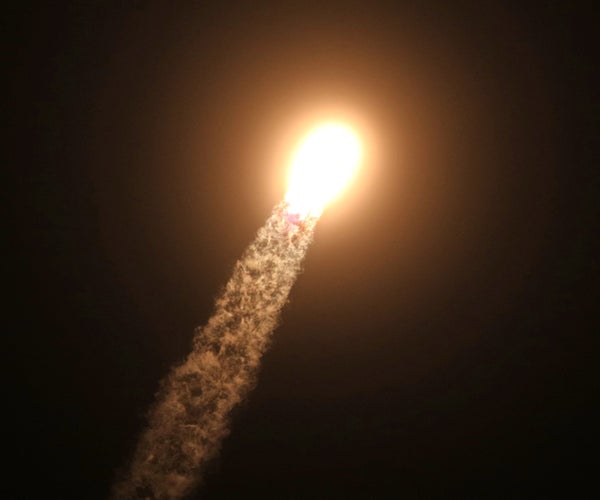
SpaceXs Fram2 Mission Sends Four Private Astronauts into Polar Orbit
www.scientificamerican.com
March 31, 20253 min readSpaceX Hits New Milestone with Fram2, the First-Ever Crewed Polar MissionThe privately funded Fram2 mission is the first ever to take astronauts into polar orbitand the latest sign of a new normal for human spaceflightBy Lee Billings edited by Dean VisserA SpaceX Falcon 9 rocket with the Fram2 mission astronauts aboard soars into a polar orbit after lifting off from Kennedy Space Center in Cape Canaveral, Florida on March 31, 2025. Gregg Newton/AFP via Getty ImagesIn some respects, the most notable thing about Fram2, the private four-person space mission that launched on Monday night on a SpaceX Falcon 9 rocket, is its polar orbit. Named after the Norwegian polar-exploration vessel Fram, the Fram2 mission marks the first time humans have occupied this particular slot around our planet, a swooping ellipse that takes a SpaceX Crew Dragon spacecraft between Earths North and South Poles in about 45 minutes. Especially when seen from a panoramic cupola attached to the spacecraft, the unique views offered by Fram2s 430-kilometer-high orbital perch are breathtakingly cooleven leaving aside the vast expanses of polar ice far below.But the notional noteworthiness of Fram2s three-to-five-day stay in polar orbit ironically belies something even more remarkable: privately funded human spaceflight is now considered so routine that any such mission seeking to make headlines desperately needs some attention-grabbing first.Why Did Fram2 Go to Polar Orbit?On supporting science journalismIf you're enjoying this article, consider supporting our award-winning journalism by subscribing. By purchasing a subscription you are helping to ensure the future of impactful stories about the discoveries and ideas shaping our world today.None of the 22 life-science-focused experiments carried onboard Fram2 demanded that it reach polar orbit, which hadnt been attempted in previous crewed missions because of the increased amount of fuel required to get there. (Fram2 flew southward from its launch site, whereas most space missions have targeted more equatorial orbits and have launched toward the east to receive a fuel-saving boost from Earths rotation). Simply put, aside from the desire for some novel gimmick, there was no clear rationale for SpaceXs mission planners or Fram2s leader, cryptocurrency billionaire Chun Wang, to have chosen a polar orbit in the first place.Why This MattersNone of this means that sending humans into that orbit isnt a legitimately impressive feat. It isall the more so because SpaceXs Falcon 9 rocket not only safely delivered the Crew Dragon to polar orbit; it also had enough leftover fuel to still perform a pinpoint soft landing on an awaiting barge in the Atlantic Ocean. But Fram2s polarity overshadows the more mundane but no less astonishing new normal, in which private human spaceflight has rapidly shifted from the stuff of science fiction to a decidedly unexceptional reality.Two screen captures from the livestream of SpaceXs launch of the private Fram2 mission, showing the glowing nozzle of the Falcon 9 rocket (left) and the spacesuit-clad Fram2 crew in the Crew Dragon capsule (right).SpaceXConsider that this is SpaceXs 17th crewed mission, of which about a third have been privately funded. Wang and his three crewmatesfilmmaker Jannicke Mikkelsen, roboticist Rabea Rogge and polar explorer Eric Philipsall rode in Resilience, the Crew Dragon vehicle that has flown three other crews (two of them private) to space. Resiliences previous private missions were both commanded by billionaire entrepreneur Jared Isaacman, who has since parlayed his SpaceX-powered passion for spaceflight into a nomination to lead NASA on behalf of the Trump administration. And the Fram2 launch occurred scarcely two weeks after the liftoff of SpaceXs NASA-funded Crew-10 mission to the International Space Stationthe shortest gap yet between the companys crewed launches, all of which have taken place as SpaceX has maintained a frenetic record-setting pace of uncrewed commercial launches and has continued the wildly ambitious development of its potentially revolutionary Starship vehicle.Whats NextOne might be tempted to think this is merely a reflection of SpaceXs success, but the rising numbers of legitimate competitors for the companys launch-industry dominance suggest otherwise. Even if SpaceX somehow falters, Blue Origin, Rocket Lab, United Launch Alliance and other launch providers all appear on track to offer broadly similar services in coming years, suggesting that this bold new era of spaceflight is here to stay.
0 التعليقات
·0 المشاركات
·14 مشاهدة


